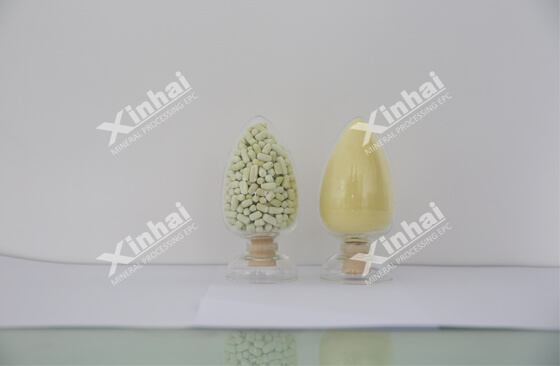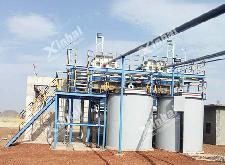

Warm Tip: If you want to know more details about equipment, solutions, etc, please click the button below for free consultation, or leave your requirements!
Gold flotation reagents can be divided into 5 types: collectors, foaming agents, inhibitors, activators, and pH adjusters. Flotation reagent is one of the key factors affecting the flotation of gold ore. It can adjust the surface properties of gold ore during the flotation process, and improve the flotation speed and selectivity. This article will briefly introduce the working principles, types and characteristics of these five types of flotation reagents for gold.
The collector is one type of gold flotation reagents, it enhances the hydrophobicity of the mineral surface by selectively fixing it on the surface of the mineral, so that the mineral is easy to adhere to the bubbles. In the flotation process, it is the "tie" that binds the ore particles to the bubbles, as shown in the figure.

( the working principle of collector flotation reagent)
Collectors commonly used in gold flotation plants are: xanthate and dithiophosphate.
Xanthate is a collector of thio compounds, and it is the most commonly used gold flotation collector for gold-bearing sulfide ores and oxide ores. Its chemical composition is hydrocarbyl dithiocarbonate, and the most widely used xanthates are ethyl xanthate and butyl xanthate.

(Xanthate sample)
Xanthate is a pale yellow powder with a pungent odor, easily soluble in water, and easily oxidized. And it is easily deliquescence in the air. Therefore, the following two points should be paid attention to during the use and storage of xanthate:
One is to prevent the decomposition of xanthate, the pH value of the pulp should be controlled above 7. Second, the aqueous solution of xanthate is easily hydrolyzed, so the prepared xanthate gold flotation reagent solution should not be stored for a long time. In production, attention should be paid to the use of the liquid chemical configured on the shift.
Dithiophosphate is commonly used for gold-containing sulfide flotation. According to the composition of the dithiophosphate, it can be divided into dithiophosphate 15, dithiophosphate 25 and butylammonium dithiophosphate.
Among them, dithiophosphate 15 contains more cresols, which has greater bubble performance than dithiophosphate 25; dithiophosphate 25 has a strong collection capacity; Butylammonium dithiophosphate is dark white powder, compared with the first two dithiophosphate, it has little odor, little corrosiveness, and is easily soluble in water.
Because dithiophosphate has a certain foaming property, the more free cresols in it, the stronger the foaming property. The chemical stability is better than xanthate, but because it is difficult to oxidize and is not easy to decompose under acidic conditions, it is more suitable for acidic pulp in gold flotation.
In the gold flotation process, minerals are loaded by foam, so the generation of bubbles of appropriate size and strength is an important condition for gold flotation.
Because the bubbles are too large, the surface area is small, and the flotation efficiency is low; if the bubbles are too small, the ability of the bubbles to attach is low;
Another property of bubbles is the lifetime of the bubbles. If the lifespan is low, the ore particles carried by the bubbles will rupture as soon as they reach the surface of the slurry or before reaching the surface of the slurry, which will inevitably affect the gold separation efficiency; if the strength of the bubbles is too high, the lifespan will be too long.
When the foam has been scraped into the concentrate foam tank or for a longer period of time, it will not burst, which will affect the transportation and dehydration of the flotation gold concentrate.
Commonly used foaming agents in gold flotation plants include pine oil, oil 2, camphor oil, and cresol acid, among which oil 2 is the most widely used.
Pine oil is one kind of gold flotation reagent that obtained by dry distillation or distillation of pine roots, pine nuts, and pine nuts. It is a mixture and has unstable properties.

(pine oil 2)
Being famous of the name of Oil 2. It is the most commonly used and abundant foaming agent in gold flotation concentrators. Oil 2 is a bright yellow oily liquid with a specific gravity of 0.9-0.91. In the flotation of vein gold, the amount of Oil 2 is 20-120g/t, most of which is 40-80g/t. Compared with other foaming agents, Oil 2 has the characteristics of strong bubble ability, uniform bubble size and proper viscosity.
As a gold flotation reagent, cresyl acid is also widely used in the practice of gold flotation. It is a by-product of the coking industry. It is easily soluble in water, has a weaker bubble ability than pine oil, is brittle and has good selectivity. It is suitable for preferential flotation of gold ore. And the dosage is generally 2-150g/t during gold flotation, the disadvantage is that it is toxic and flammable.
As one type of gold flotation reagents, inhibitor can reduce the floatability of minerals. Its function is to selectively interact with minerals to cause hydrophilicity on the surface of minerals. These minerals are inhibited during the flotation process. The other function is to saturate or dissolve the collector from the surface of the mineral to help capture. The active film of the collector acts and reduces the concentration of the active examples in the solution, making it difficult to form a collector film on the surface of the mineral.
In gold flotation plant, the commonly used inhibitors are: lime and cyanide.
Lime is an effective inhibitor of minerals such as pyrite and pyrrhotite, and can also be used as a pH regulator. Lime is easy to obtain and low in price. It is a commonly used inhibitor, and it is also an agglomeration agent for sludge.
Cyanide is a very sensitive inhibitor for gold and gold-iron ore flotation. In the gold dressing plant of cyanide leaching, attention should be paid to the influence and pollution of cyanide-containing wastewater on the flotation slurry.
The function of the activator is to create a film that promotes the adhesion of the collector on the surface of the mineral, improve the floating ability of the mineral, remove the inhibitory film on the surface of the mineral, and restore the original floating activity of the mineral.
The activators commonly used in gold flotation plants are: sodium sulfide and sulfuric acid.
Sodium sulfide is forbidden in the cyanidation process of flotation concentrates, because S2− will react with CN− during the cyanidation process to consume cyanide.

(sodium sulfate sample)
Sulfuric acid and sulfur dioxide gas have an activating effect on the pyrite that has been kept.
The pH adjuster is a kind of gold flotation reagent that adjusts the dispersion and agglomeration of mineral mud by influencing the surface properties of minerals, adjusting the vitality of other medicaments, eliminating the influence of harmful ions.
Commonly used regulators in gold flotation plants are: lime, sodium carbonate, caustic soda and sulfuric acid.
Sodium carbonate makes the solution alkaline and is a commonly used pH regulator in gold flotation, which can adjust the pH of the slurry to 8-10.
Due to the high price, sodium carbonate is not widely used.
Sulfuric acid is an acid regulator gold flotation reagent. In the gold flotation process, sulfuric acid is mostly used to activate pyrite that was inhibited by lime. Adding sulfuric acid can reduce the pH value of the pulp to below 7.
The above is a brief introduction to several commonly used gold flotation reagents. Although there are many types of flotation reagents, due to the differences in chemical properties, efficacy, price, storage and environmental protection, there are only dozens of commonly used in production practice. Here I have summarized the widely used gold flotation reagents. Before choosing a gold flotation reagent, it is recommended that the mine owner do a flotation test to determine the most suitable reagent for your gold flotation plant.


What Are the Differences Between CIP and CIL?
 11176
11176
 0
0